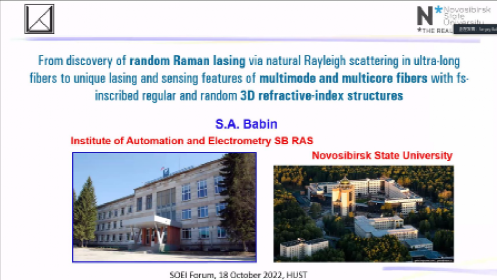Invited by Prof. Luming Zhao, Professor Sergey A. Babin from the Institute of Automation and Electrometry of RAS Siberian Branch gave an online lecture in the Photoelectric Information Lecture Hall on October 18, 2022, the topic of the lecture was “From discovery of random Raman lasing via natural Rayleigh scattering in ultralong fibers to unique lasing and sensing features of multimode and multicore fibers with fs-inscribed regular and random 3D refractive-index structures”. The Lecture attracted a lot of students and teachers to attend. The Lecture is partially supported by High-end Foreign Experts Project, the Sino-Russian Joint Center for Ultrafast Laser Basic Research - Joint Scientific Research Platform Cultivation Program Russia-Ukraine Special Project - "Double First-Class" International Cooperation Special Project。

Fig. 1Prof.Sergey A. Babin’s ppt
In the lecture, Prof. Sergey A. Babin systematically introduces his research work:from basics ofsingle mode fiber lasers to multimode fiber Raman lasers and LD-pumped GRIN-fiber RFL with fs-inscribed FBG cavity. Research work on pump and Stokes beam shapes in GRIN-fiber RFL, bightness enhancement, mechanism of brightness enhancement/beam cleaning in GRIN-fiber RFL, power scaling, 3D FBG/random structure, LD-pumped SI-fiber RFL, fs-inscribed FBGs in multicore passive fibers, Raman lasing in 2-core PM fiber with fs-FBGs and RBS, Raman lasing in 7-core fiber with random fs-FBG array, fs-inscribed FBGs in multimode passive fibers, and Raman lasing in LD-pumped multimode fiber with fs-FBG and RBS. Various laser and sensor systems for industrial applications (communications, biomedicine, material processing, infrastructure and energetics) have been realized.
Prof. Sergey A. Babin spoken to us from discovery of random Raman lasing via natural Rayleigh scattering in ultra-long fibers, speaker will introduce the unique lasing and sensing features of multimode and multicore fibers with fs-inscribed regular and random 3D refractive-index structures. The multimode and multicore fibers with fs-inscribed regular and random 3D refractive-index structures enabling both new fundamental effects and new opportunities in practical applications
Prof. Babin made a very successful lecture with beautiful pictures and rich results for students to understand. During the Q&A session, the audience and Prof. Babin have made a lively discussion.


Fig. 2 Applications of Raman fiber lasers
Sergey A. Babin:
Sergey A. Babin received MSc in physics from the Novosibirsk State University in 1983, and PhD (1990) and DSc (2003) degrees in physics and mathematics from the Institute of Automation and Electrometry of RAS Siberian Branch (Novosibirsk, Russia). He has been working as a head of the Fiber Optics Laboratory since 2007, and as a director of the Institute since 2018. He is also Professor of Novosibirsk State University reading lectures on fiber optics at Physics department. He is a member of OSA, SPIE and IEEE Photonics societies, chief editor of Applied Photonics journal (in Russian), and topical editor of Laser Physics and other journals. For his scientific achievements he has been elected to be a corresponding member of Russian Academy of Sciences (RAS). His achievements include the development in collaboration with colleagues from MPE Garching (Germany) of a first powerful laser guide star source in 2000, the longest fiber laser (up to 300 km) with colleagues from Aston university (UK) in 2009, in which the role of random Rayleigh back-scattering is shown to become important. Starting from 2010, he and his team proposed and demonstrated random Raman fiber lasers with record parameters (efficiency, polarization extinction ratio, flat tuning and multi-wavelength regimes, etc.), as well as other novel schemes and regimes of Raman fiber lasers.
